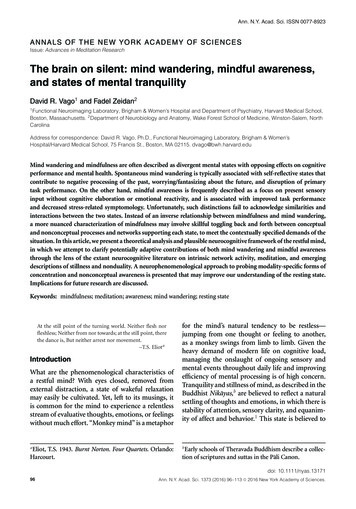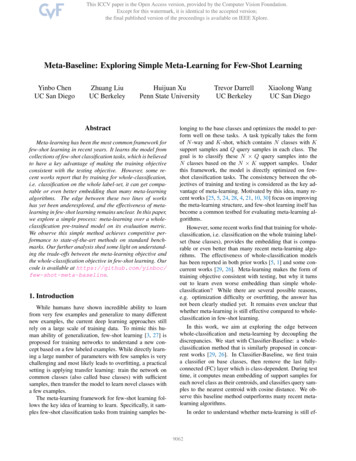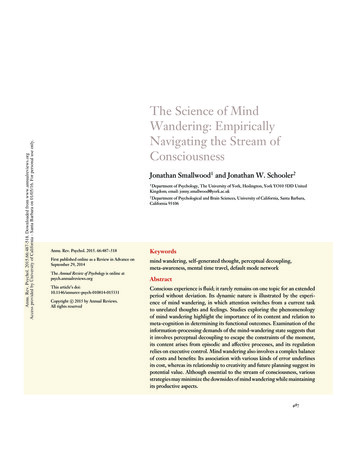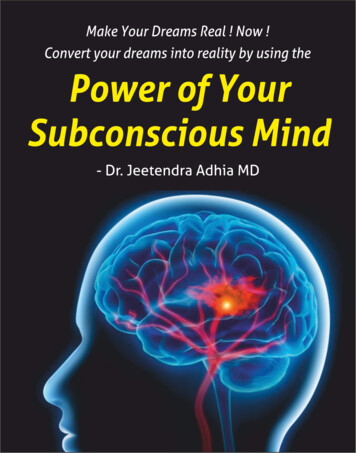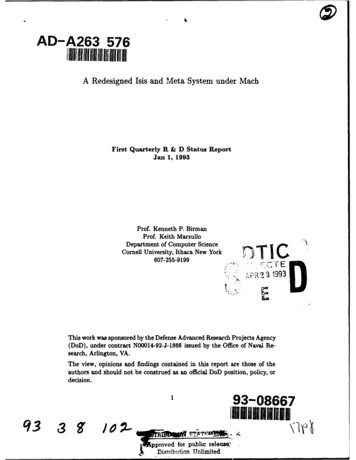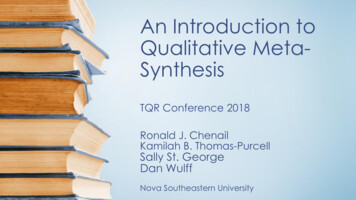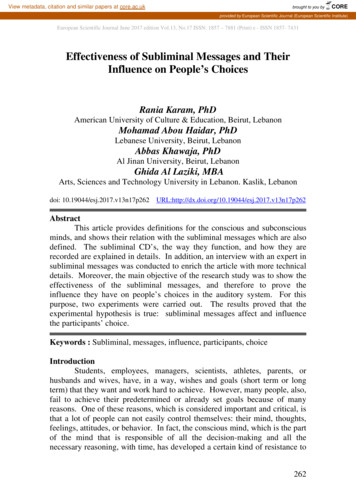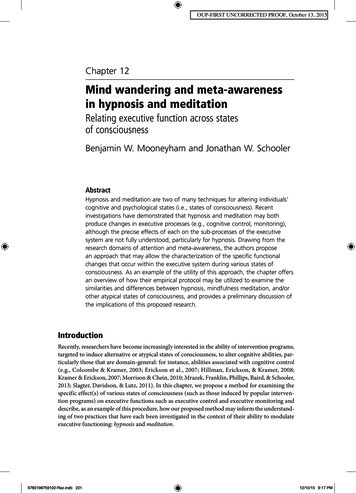
Transcription
OUP-FIRST UNCORRECTED PROOF, October 13, 2015Chapter 12Mind wandering and meta-awarenessin hypnosis and meditationRelating executive function across statesof consciousnessBenjamin W. Mooneyham and Jonathan W. SchoolerAbstractHypnosis and meditation are two of many techniques for altering individuals’cognitive and psychological states (i.e., states of consciousness). Recentinvestigations have demonstrated that hypnosis and meditation may bothproduce changes in executive processes (e.g., cognitive control, monitoring),although the precise effects of each on the sub-processes of the executivesystem are not fully understood, particularly for hypnosis. Drawing from theresearch domains of attention and meta-awareness, the authors proposean approach that may allow the characterization of the specific functionalchanges that occur within the executive system during various states ofconsciousness. As an example of the utility of this approach, the chapter offersan overview of how their empirical protocol may be utilized to examine thesimilarities and differences between hypnosis, mindfulness meditation, and/orother atypical states of consciousness, and provides a preliminary discussion ofthe implications of this proposed research.IntroductionRecently, researchers have become increasingly interested in the ability of intervention programs,targeted to induce alternative or atypical states of consciousness, to alter cognitive abilities, particularly those that are domain-general: for instance, abilities associated with cognitive control(e.g., Colcombe & Kramer, 2003; Erickson et al., 2007; Hillman, Erickson, & Kramer, 2008;Kramer & Erickson, 2007; Morrison & Chein, 2010; Mrazek, Franklin, Phillips, Baird, & Schooler,2013; Slagter, Davidson, & Lutz, 2011). In this chapter, we propose a method for examining thespecific effect(s) of various states of consciousness (such as those induced by popular intervention programs) on executive functions such as executive control and executive monitoring anddescribe, as an example of this procedure, how our proposed method may inform the understanding of two practices that have each been investigated in the context of their ability to modulateexecutive functioning: hypnosis and meditation.9780198759102-Raz.indb 22112/10/15 9:17 PM
OUP-FIRST UNCORRECTED PROOF, October 13, 2015222Mind wandering and meta-awareness in hypnosis and meditationWe begin by briefly considering what is already known about the relationship between hypnosis and meditation. This analysis reveals that while these two psychological interventionsshare some striking similarities, they also diverge in ways that have not yet been fully characterized, warranting further empirical investigation aimed at assessing the functional similaritiesand differences in executive functioning resulting from hypnosis and meditation. Toward thisend, we propose an experimental methodology that may permit both the assessment of theparticular changes in executive functioning that are associated with hypnosis, mindfulnessmeditation, or other atypical state of consciousness, and the direct comparison of the effectsof each state within a common experimental design. Our proposed approach, adapted fromthe research domains of mind wandering and meta-awareness, may offer important insightsregarding the relationship between executive processes and various states of consciousness. Inthis chapter, we employ hypnosis and mindfulness meditation as examples of atypical states ofconsciousness, and explore how our proposed approach may shed light upon three unresolvedresearch issues related to these particular states: the specific dissociative effects of hypnosis, theeffects of meditation practice on executive functioning, and the relationship between hypnosisand meditation.Hypnosis versus meditationWhat is the relationship between meditation and hypnosis? This question has garnered significantinterest recently (see Part 3 of this volume). At the surface, meditation and hypnosis share severalbasic similarities, but upon closer examination it becomes clear that we do not yet fully understand either practice or the precise mechanisms by which they differ from each other.Characteristics shared by hypnosis and (mindfulness) meditationHypnosis and meditation are practices associated with several common principles.RelaxationBoth hypnosis and meditation participants often report feeling relaxed (Benson, Greenwood, &Klemchuk, 1975; Lynn, Brentar, Carlson, Kurzhals, & Green, 1992; Lynn, Malaktaris, Maxwell,Mellinger, & van der Kloet, 2012; Wallace, Benson, Wilson, 1984). However, relaxation is notrequired in order for hypnotic responding to occur. Moreover, meditative states can also be distinguished from relaxation states (such as with electroencephalography (EEG); Dunn, Hartigan,& Mikulas, 1999), suggesting that while relaxation may typically occur during hypnosis andmeditation alike, neither state’s effects can be reduced to the effects of the relaxation that occurswithin the state.AbsorptionBoth hypnosis and meditation are absorptive practices (see Chapter 14). Absorption can be measured at the trait level, where it indicates a dispositional tendency to experience episodes in whichone’s “total” attention fully engages one’s representational (i.e., perceptual, enactive, imaginative,ideational) resources (Tellegen & Atkinson, 1974). Assessments of absorption have been made inrelation to both hypnosis and meditation; absorption correlates positively with hypnotizability(Tellegen & Atkinson, 1974), while long-term meditators indicate higher levels of absorption thando novice meditators (Davidson, Goleman, & Schwartz, 1976). While the particular absorptionthat occurs during hypnosis and meditation may differ (see Semmens-Wheeler & Dienes, 2012,for a discussion of four modes of mental processing that may each be associated with different9780198759102-Raz.indb 22212/10/15 9:17 PM
OUP-FIRST UNCORRECTED PROOF, October 13, 2015Hypnosis versus meditation223“types” of absorption), it is nonetheless reasonable to assert that both practices are associated withsome form of attentional absorption.Characteristic distinctions between hypnosis and meditationDespite the commonalities shared between hypnosis and meditation, several key differencesbetween these two practices have made it difficult to precisely determine the relationshipbetween them.Attentional regulation/controlIn hypnosis, attention is typically directed toward some external object or behavior, and this direction of attention results from a command or suggestion given by the hypnotist to the individualundergoing hypnosis. As such, attentional control is, in a manner, relegated to the hypnotist andthe locus of attention determined through the specific suggestions given to the hypnotized individual. Interestingly, meditation practice often begins in a similar fashion, in which an instructorprovides suggestions for the student regarding toward where and what to direct their attention(see Chapter 19). However, over the course of practice, experienced meditators come to controltheir attention internally (likely by training their meta-cognitive abilities; see Semmens-Wheeler& Dienes, 2012) and, in contrast to what occurs during hypnosis, learn to focus their attention noton some external action or object, but on their own internal states and experiences.There is ample evidence that meditation practice leads to attentional improvements. Forinstance, experienced meditators exhibit less Stroop interference than controls during the Strooptask (Moore & Malinowski, 2009; Wenk-Sormaz, 2005), indicating improved attentional controland an ability to override a supposedly automatic process (see Chapter 16). While meditation practice has been shown to improve attentional abilities in a variety of studies, the effect of hypnosison attention is much less straightforward. Without a hypnotic induction or a task-relevant suggestion, most studies have shown that high-hypnotizable individuals do not demonstrate improvedattentional abilities, as measured by Stroop interference (e.g., Egner, Jamieson, &Gruzelier, 2005;Jamieson & Sheehan, 2004; Kaiser, Barker, Haenschel, Baldeweg, & Gruzelier, 1997; Kallio,Revonsuo, Hamalainen, Markela, & Gruzelier, 2001; Nordby, Jasiukaitis, & Spiegel, 1999).Effect of suggestionWhile high-hypnotizable individuals do not possess improved attentional abilities in theabsence of a hypnotic induction or task-relevant suggestion, the story changes once a suggestion is given. When given a suggestion to view words presented in a Stroop task as meaningless,high- hypnotizable individuals actually show improved Stroop performance (Parris, Dienes, &Hodgson, 2012; Raz, Shapiro, Fan, & Posner, 2002; Raz et al., 2003). This points to the importanceof suggestion within hypnotic responding, and demonstrates that high-hypnotizable individualsthat have been given a specific suggestion may indeed have superior attentional abilities in comparison to low-hypnotizable individuals (even when the low hypnotizables also receive a suggestion) who show no improvements in Stroop performance when given the same suggestion.Hypnotizability is measured through suggestibility, such that individuals who are more likelyto respond in accordance with external suggestions are deemed more hypnotizable. As such,the internal state of high hypnotizables may be more malleable than it is for others, which mayallow these individuals to respond to suggestions in ways that improve their attentional performance. However, while individuals with meditation practice also show improved attentionalperformance, they are generally less suggestible; Semmens-Wheeler and Dienes (2012) reportthat an examination of 12 expert meditators revealed that they were less suggestible than average9780198759102-Raz.indb 22312/10/15 9:17 PM
OUP-FIRST UNCORRECTED PROOF, October 13, 2015224Mind wandering and meta-awareness in hypnosis and meditation(passing 3 out of 12 suggestions, compared to an average of 5.5 suggestions passed). Additionally,across over 500 participants, hypnotizability negatively correlated with mindfulness (r –0.38;Semmens-Wheeler & Dienes, 2012).These results lead to a seemingly paradoxical conclusion: instructing high-hypnotizable individuals to respond less mindfully (i.e., hypnotically, as in the Stroop studies with task-relevantsuggestions) leads them to perform better on the same attention tasks upon which meditationtraining improves performance (Semmens-Wheeler & Dienes, 2012; for an updated account ofthis research, including more recent findings, see Chapter 7). Additionally, while meditators maybe less suggestible as a result of their meditation practice, it is suggestion that enables the improvement in attentional performance in high hypnotizables to occur.The need to examine attention and executive processing in bothhypnosis and meditationDespite the similarities between hypnosis and meditation, a closer examination of the effects ofeach practice reveals that the distinction between the two may not be made simply. In order tomore fully understand the relationship between hypnosis and meditation, it may be necessary toinvestigate the effects of each practice at a more fine-grained level by independently examiningthe component sub-processes of attention and executive processing. We propose an empiricalframework in which to examine the effects of each practice on these sub-processes of executivefunctioning within a single experimental design, and we will outline our proposed approach inthe sections to come. First, we discuss current and competing theories of hypnosis, as our protocolmay disambiguate a variety of hypnosis-related findings and possibly provide evidence in favor ofone theory of hypnosis or another.Dissociation theories of hypnosisVarious theories of hypnosis exist that posit that some form of dissociation occurs during hypnosis (e.g., Bowers, 1992; Bowers & Davidson, 1991; Hilgard, 1977; Jamieson & Woody, 2007; Janet,1901, 1907). However, the type of dissociations proposed within the various theories differ, and adistinction can be made between theories that posit a dissociation of experience versus a dissociation of control.Dissociation of experienceTheories of dissociated experience within hypnosis have been around for some time (Janet, 1901,1907), perhaps reflecting the extent to which these theories capture the central feature of hypnosis: the lack of experienced volition. The most prominent of these theories is Hilgard’s (1977)“neo-dissociation” theory. This theory proposes that the lack of consciously perceived volitionthat coincides with the hypnotic state is the result of an amnesia-like barrier, which blocks somemental activity from the conscious access it would have in a non-hypnotic circumstance. As such,while a hypnotized individual may have no “conscious” awareness of the volition that accompanies their actions under hypnosis, it is not because volition is lacking, but, rather, because thehypnotized individual becomes dissociated from their own experience of volition. Thus, onemay be fully capable of exerting volitional control of one’s actions while under hypnosis, buthypnosis may produce a barrier between conscious experience and its subsequent reportability.Additionally, through investigation, Hilgard claimed that, with appropriate suggestions employed,one could access a hidden observer, a conscious entity capable of reporting mental activity that had9780198759102-Raz.indb 22412/10/15 9:17 PM
OUP-FIRST UNCORRECTED PROOF, October 13, 2015Dissociation theories of hypnosis225otherwise been blocked from awareness (Hilgard, 1991, 1994; Hilgard, 1977). This led to the conclusion that hypnosis may produce parallel streams of consciousness (through the amnesia-likebarrier) that are largely unintegrated.Given researchers’ largely unsuccessful attempts to verify the hidden observer (Green, Page,Handley, & Rasekhy, 2005; Spanos, 1983; Spanos & Hewitt, 1980; Spanos, de Groot, Tiller,Weekes, & Bertrand, 1985), Hilgard’s (1977) “neo-dissociation” theory of hypnosis has been metwith skepticism. However, Hilgard also argued that hypnotic responses might appear to lackvolition (from the perspective of the one hypnotically responding) through a different mechanism (instead of the proposed amnesia-like barrier): circumvention around executive controlprocesses. If hypnotic suggestions are able to bypass the “executive control” system, they may actdirectly on lower “subsystems of control,” thereby initiating the acts demanded by the suggestionwithout executive initiative. Such a process would produce a similar feeling of a lack of consciousvolition, but this feeling would result from an actual dissociation of control, in that the suggestionwould take effect regardless of the “intent” of the executive control system. With this in mind,Bowers (1992) proposed that neo-dissociation theory should be divided into two separate theories: theories of dissociated experience and theories of dissociated control.Dissociation of controlOriginally stemming from neo-dissociation theory itself, Bowers (1992) first formalized the dissociated control theory of hypnosis. This theory postulates that hypnosis alters control processesthemselves rather than merely altering perceived control. In its most basic form, the idea is simple: in hypnosis, the lower “subsystems of control” (such as those involved in coordinating motormovements, lexical processing, etc.) may be directly influenced by suggestion. Such direct accessmay permit these subsystems of control to produce behaviors that are not directed, initiated, orgoverned by the higher-level executive control system. Thus, actions performed under hypnosiswill lack the usual amount of intervention from executive control processes, and will therefore beperceived to have occurred without volitional control (Sadler & Woody, 2010).Investigations of executive control processes during hypnosis have lent support to the idea thathypnosis involves some form of dissociated control. Many of these studies have utilized classic“frontal lobe” tasks, such as the Stroop task, to demonstrate that high-susceptible individuals tendto make more errors and suffer greater interference (as measured by reaction time) on the Strooptask than low-susceptible individuals (either while under hypnosis or after a de-induction thatwas preceded by a hypnotic suggestion) (Jamieson & Sheehan, 2004; Kaiser et al., 1997; Nordbyet al., 1999; Sheehan, Donovan, & MacLeod, 1988). Dissociated control accounts of hypnosisare bolstered by neuroimaging and electroencephalographic reports of increased activation inconflict-monitoring areas of the brain (specifically, the dorsal anterior cingulate cortex; dACC)for high-susceptible individuals while performing the Stroop task under hypnosis, as well asthe finding that the functional connectivity between this conflict-detection region and another“cognitive-control” region, the lateral prefrontal cortex (lPFC), is decreased during the Stroopfor high-susceptible individuals while under hypnosis (Egner et al., 2005), a finding which suggests that hypnosis limits the degree to which control processes are able to adjust in response todetected conflict.Inferring the role of “control” itself in hypnosis from Stroop-like tasks is difficult, however,as it is often unclear whether performance decrements in the Stroop task are due to deficits inconflict monitoring, signaling between conflict monitoring and cognitive-control systems, maintaining and implementing appropriate task set variables within the cognitive-control system, or9780198759102-Raz.indb 22512/10/15 9:17 PM
OUP-FIRST UNCORRECTED PROOF, October 13, 2015226Mind wandering and meta-awareness in hypnosis and meditationother processes (Egner & Raz, 2007). Although recent studies have attempted to further clarifythe origin of poor Stroop performance under hypnosis, with some success, isolating the changesthat occur within particular component processes (and their interactions) during hypnosis will beimportant to fully explain hypnosis; it is also a central aim of our proposed study.A variant, and more specific, form of dissociated control theory, the second-order theory of dissociated control (a term coined by Woody & Sadler, 1998), also posits that the effect of hypnosis isexerted through dissociated control, but with different locus of dissociation. (This theory sharessubstantial overlap with the ideas put forth by Jamieson and colleagues in their recent work;Egner et al., 2005; Jamieson & Sheehan, 2004; Jamieson & Woody, 2007). Rather than having thedissociation occur between the higher-level executive control system and the lower subsystems ofcontrol, the second-order theory of dissociated control states that the dissociation occurs, instead,between the higher-level executive control system and the executive monitoring system, such thatthe executive monitoring system is unable to modulate any directive imposed by the executivecontrol system once the directive has been initiated. This idea is supported by findings that suggest that it may not be a lack of executive processing per se that is responsible for the relationshipbetween hypnosis and poor performance in tasks like the Stroop but, rather, a disconnect betweenexecutive monitoring and cognitive control systems: Egner et al. (2005) showed that, while aconflict-detection region of the brain (dACC) showed increased activity for high-susceptibleindividuals performing the Stroop task under hypnosis, no corresponding increase was observedin a key cognitive-control region (the lPFC), suggesting that there may be a disconnect in communication between these monitoring and control regions during hypnosis. Furthermore, theseregions showed decreased functional connectivity during the Stroop task for the high-susceptibleindividuals, providing direct evidence in support of the notion of second-order dissociated control.Woody & Sadler’s integrative modelIn response to the propagation of various dissociative theories of hypnosis, Woody and Sadler(Sadler & Woody, 2010; Woody & Sadler, 2008) presented an “integrative model” in which thedissociations predicted by alternative theories could each be depicted within a single framework(see Figure 12.1).In this model, separate functional modules are depicted for executive control, executive monitoring, and the subsystems of control, with suggestion serving as the input and behavior serving asthe output. As such, the model depicts two levels of control: the higher level consists of executivecontrol and executive monitoring, while the lower level is more diverse and consists of various“system-specific” control processes; these “subsystems of control” within the lower level are variegated in nature, comprising constituent and domain-specific processes (such as visual search,word recognition, or motor function) underlying more complex behaviors. Furthermore, themodel posits two feedback loops: one loop going from executive control to the subsystems of control, to executive monitoring, and then repeating; the other going reciprocally between executivecontrol and executive monitoring.Each of these loops are enacted via functional connections between the modules within themodel (labeled paths A–E in Figure 12.1) and, according to dissociative theories of hypnosis, it isthe relative strengths of these connections that are predicted to change within the hypnotic state.However, the prediction of which particular paths change in strength during hypnosis is determined by the theory being considered. For instance, the theory of dissociated experience predictsthat the dissociative effect of hypnosis occurs through a dampening of paths C and E, whereinformation regarding executive control is prevented from reaching awareness in the executive9780198759102-Raz.indb 22612/10/15 9:17 PM
OUP-FIRST UNCORRECTED PROOF, October 13, 2015AQ1A study proposal: testing the locus of hypnotic dissociation and comparing hypnotic estion227Subsystems of ControlBehaviorFig. 12.1 Woody and Sadler’s (2008) integrative model.This material has been adapted from Erik Z. Woody and Pamela Sadler, Dissociation theories of hypnosis, In Michael R.Nash and Amanda J. Barnier (eds), Oxford Handbook of Hypnosis, p. 90, figure 4.2 2012, Oxford University Press,and has been reproduced by permission of Oxford University Press word Oxford%20handbook%20of%20hypnosis. For permission to reuse this material, please visit onitor (path C); such an inhibition may therefore explain why individuals lack awareness oftheir executive control efforts (i.e., it may simply be because this effort does not get monitoredsufficiently enough to reach awareness). Additionally, a more pronounced dissociation of experience (like the form originally proposed by Hilgard) would also involve dampening the outputsfrom the subsystems of control to the executive monitoring system (path E), thus producing“amnesia” for one’s actions altogether.The theory of dissociated control, on the other hand, posits a reduction in the strength of pathB, where the subsystems of control operate without “normal” amounts of executive control beingimposed upon them. Thus, the dissociation does not involve a misperception of experience but,rather, a real inability to executively control one’s actions under hypnosis.Finally, the second-order theory of dissociated control predicts a weakening of path D, wherethe executive monitoring system is therefore unable to modulate the operation of the executivecontrol system, leading to more rigid and less flexible behaviors under hypnosis.A study proposal: testing the locus of hypnotic dissociationand comparing hypnotic versus meditative effectsDespite a rapid accumulation of findings from empirical investigations into hypnosis and meditation, we have yet to reach a clear understanding of the particular functional changes induced byeither activity. We have, as of yet, been unable to reach strong conclusions about how the dissociative effects of hypnosis ought to be characterized, while at the same time, the relationship betweenthe effects of hypnosis and meditation remains largely speculative. We propose that, in order tobetter resolve this issue, researchers must consider the effects of each activity within a commonand comprehensive model of executive functioning. Furthermore, an investigation aimed at distilling the particular functional effects of either meditation or hypnosis (or both) must be ableto simultaneously examine each individual functional “connection” within the comprehensivemodel. If a method can be established to measure each functional connection independentlywithin a single experimental design, then we may be able to specify the particular functional9780198759102-Raz.indb 22712/10/15 9:17 PM
OUP-FIRST UNCORRECTED PROOF, October 13, 2015228Mind wandering and meta-awareness in hypnosis and meditationconnections that are targeted by hypnotic inductions, meditation practice, or other experienceswhich produce atypical states of consciousness (such as drug use, brain injury, or the experienceof “flow”).We now present a design for a possible approach, rooted in Woody & Sadler’s (2008) integrativefunctional model, that would attempt to separately measure the effects of hypnosis and meditation (or any other atypical state of consciousness) on each individual component “connection”within the model, thereby allowing for a more rich understanding of both the particular functional effects of each activity, as they pertain to executive functioning, and also the functionalrelationship between the practices/states under investigation.One design, every path?Is it possible to characterize the functional changes associated with hypnosis and/or meditationwithin Woody and Sadler’s integrative model, and can changes along each path be quantifiedwithin a single study? In order to do so, several requirements must be met:1 Measure the effect of suggestion alone (compared to suggestion plus hypnosis or suggestionplus meditation; path A)2 Measure executive control exerted upon “subsystems of control” (path B)3 Measure executive control exerted upon executive monitoring (path C)4 Measure the effect of executive monitoring (e.g., meta-awareness) on executive control(path D)5 Measure awareness of output from subsystems of control (path E).To meet these requirements, a study needs to combine methodologies. First and foremost,the study must assess cognitive control (such as in the context of sustained attention orresponse inhibition); this enables a measure of path B. Secondly, the study must assess individuals’ awareness of not only their performance but of their fluctuations in cognitive control;this allows paths E and C, respectively. Thirdly, the dependent measure related to the effect ofthe imposed suggestion must be independent of other influences, permitting a measurementof path A. Finally, the study must measure individuals’ propensity/ability to adjust their cognitive control in the face of performance-related cues that reach awareness, in order to assesspath D.A proposed studyWhat follows is a description of a study design that represents one possible approach toward isolating the specific effects of hypnosis and meditation on cognitive control and awareness withinthe framework of an integrative model of hypnosis. Such an approach should be able to assesschanges in the “strength” of each of the various paths within the model (e.g., paths A throughE in the aforementioned integrative model; see Figure 12.1) that occur during either hypnosisor meditation. The approach that we outline here is largely borrowed from a methodology withwhich the present authors are familiar: to combine a task requiring sustained attention to externalstimuli with assessments of on-line meta-awareness. This is a common procedure in the domainof mind wandering (e.g., Christoff, Gordon, Smallwood, Smith, & Schooler, 2009; Levinson,Smallwood, & Davidson, 2012; Smallwood et al., 2008; Smallwood & Schooler, 2006). We believethat this procedure has the capacity to isolate changes along each functional path within Woodyand Sadler’s integrative model, thus potentially providing useful insights into the nature of hypnosis and meditation.9780198759102-Raz.indb 22812/10/15 9:17 PM
OUP-FIRST UNCORRECTED PROOF, October 13, 2015A study proposal: testing the locus of hypnotic dissociation and comparing hypnotic versus229Basic designThe basic concept of the study is to compare the effects of a hypnotic induction plus suggestionor a meditation practice session plus suggestion to the effects of suggestion alone, within a taskdesign that allows for each path within the integrative model to be separately tested. As such, weenvision this study to have three between-subject conditions:1 Hypnotic induction plus task-based suggestion2 Meditation practice plus task-based suggestion3 Task-based suggestion only.By employing these three conditions, this study would allow for the effect(s) of hypnosis to beisolated from the effect of suggestion (by comparing the hypnotic-induction (with suggestion)group to the suggestion-only group). The effect(s) of meditation may be similarly isolated bycomparing the meditation (with suggestion) group to the suggestion-only group. Finally, thisdesign may also allow for the effect(s) of hypnosis plus suggestion to be compared to the effect(s)of meditation plus suggestion, a comparison that may shed light on the fundamental relationshipbetween these two practices.Because the integrative model includes paths directly related to aspects of executive control andawareness, the task must garner measurements separately related to each of these. As such, thestudy should include a task that c
Attentional regulation/control In hypnosis, attention is typically directed toward some external object or behavior, and this dir-ection of attention results from a command or suggestion given by the hypnotist to the individual undergoing hypnosis. As such, attentional control is, in a manner, relegated to the hypnotist and
